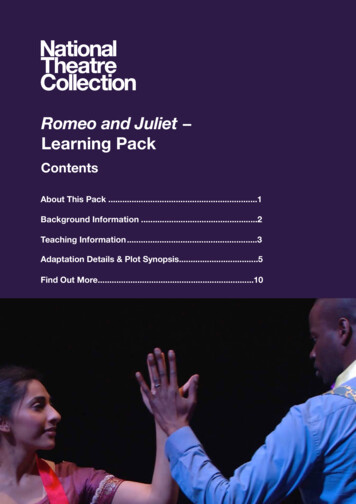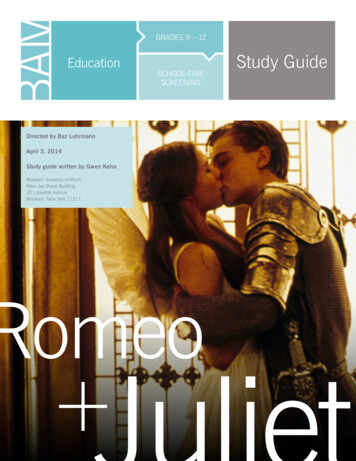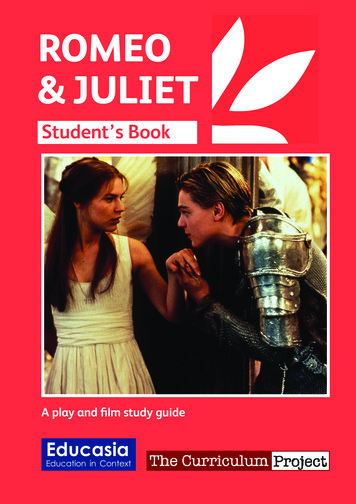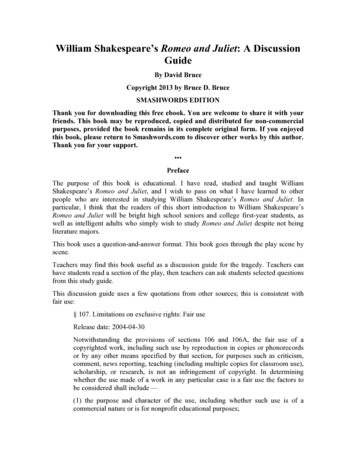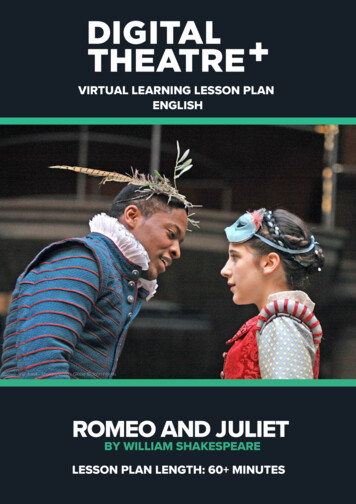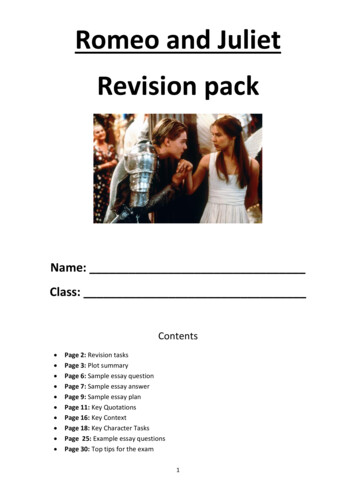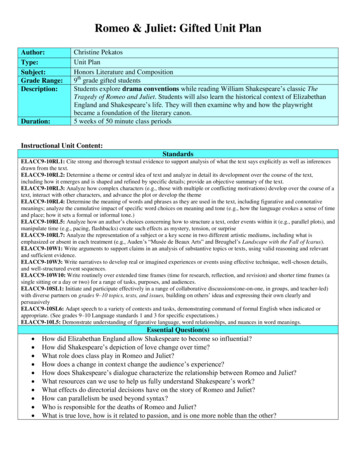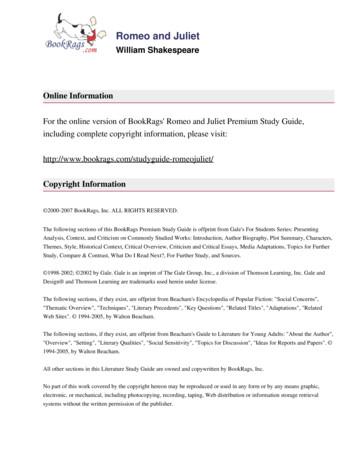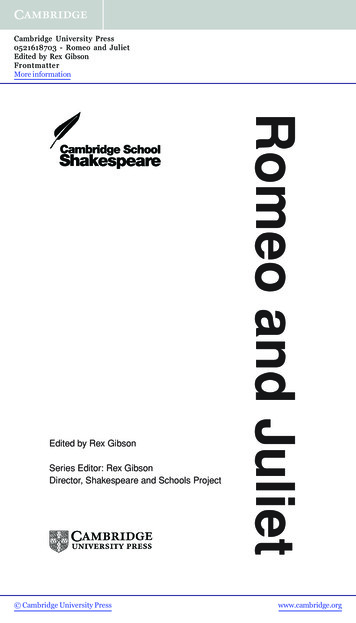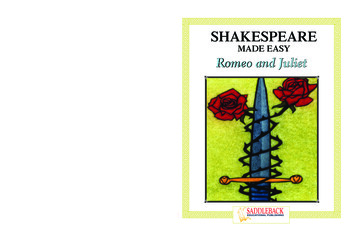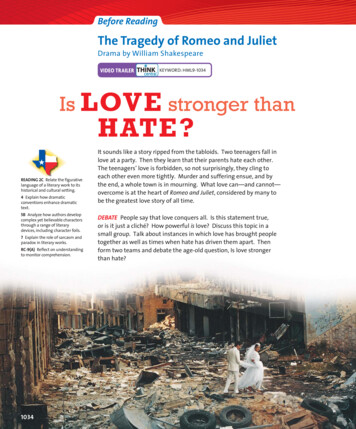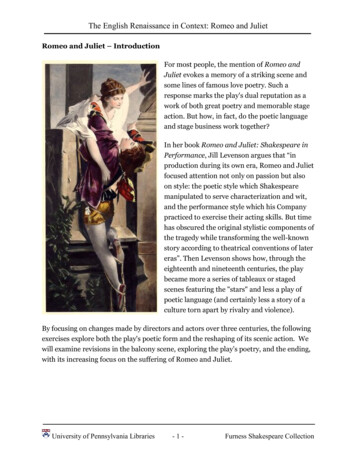
Transcription
The English Renaissance in Context: Romeo and JulietRomeo and Juliet – IntroductionFor most people, the mention of Romeo andJuliet evokes a memory of a striking scene andsome lines of famous love poetry. Such aresponse marks the play's dual reputation as awork of both great poetry and memorable stageaction. But how, in fact, do the poetic languageand stage business work together?In her book Romeo and Juliet: Shakespeare inPerformance, Jill Levenson argues that “inproduction during its own era, Romeo and Julietfocused attention not only on passion but alsoon style: the poetic style which Shakespearemanipulated to serve characterization and wit,and the performance style which his Companypracticed to exercise their acting skills. But timehas obscured the original stylistic components ofthe tragedy while transforming the well-knownstory according to theatrical conventions of latereras”. Then Levenson shows how, through theeighteenth and nineteenth centuries, the playbecame more a series of tableaux or stagedscenes featuring the "stars" and less a play ofpoetic language (and certainly less a story of aculture torn apart by rivalry and violence).By focusing on changes made by directors and actors over three centuries, the followingexercises explore both the play's poetic form and the reshaping of its scenic action. Wewill examine revisions in the balcony scene, exploring the play’s poetry, and the ending,with its increasing focus on the suffering of Romeo and Juliet.University of Pennsylvania Libraries-1-Furness Shakespeare Collection
The English Renaissance in Context: Romeo and JulietThe Balcony SceneThe "balcony scene" begins with Romeo's extended speech describing Juliet, whom heand the audience see, but she does not know that she is being tedbooksNew/index.cfm?TextID rj f1&PagePosition 7? What is the audience meant to learn and feel from this speech? AboutJuliet? About Romeo?As many scholars have noted, in writing Romeo and Juliet Shakespeare used thelanguage and style of the love sonnets of his time. Shakespeare himself, of course, wrotehis own sonnet sequence. You can link here to a version of his Poems of that was editedin 1640.University of Pennsylvania Libraries-2-Furness Shakespeare Collection
The English Renaissance in Context: Romeo and Juliet?What are the main features of the kind of love poetry Romeo delivers in thisspeech?One of the most important features is the language of comparison. In particular, thiskind of poetry compares the beloved and lover to things and events in nature (as well asimagining that the beloved influences nature). Shakespeare himself wrote two sonnetscommenting on the practice of comparison.? What perspective do these poems give you on Romeo's languagehere? How does Romeo's language paint his character? As sensitive? Asexcessive?University of Pennsylvania Libraries-3-Furness Shakespeare Collection
The English Renaissance in Context: Romeo and JulietYou might want to compare the poetry he uses earlier to describe his love for Rosalinewith the poetry he uses to describe his love for Juliet.As with so many of Shakespeare's plays, however, in its post-Shakespearean afterlifeRomeo and Juliet was rewritten and cut to suit the ears, eyes, and hearts of newaudiences, who had very different theatrical tastes.The version that had the greatest impact was David Garrick's rewriting of the play in1750. David Garrick (1717-79) was one of the most influentialactors and theater managers of England in the eighteenthcentury. He revolutionized both the acting and staging oftheater in his time (for example, by introducing stagelighting). He also revived Shakespeare on the London stage,while significantly altering the texts of many of the plays.His acting used a natural style that was new in its day.Garrick's Romeo and Juliet was first performed in 1747, andUniversity of Pennsylvania Libraries-4-Furness Shakespeare Collection
The English Renaissance in Context: Romeo and Juliethe published his first version of the play in 1748. In this edition, he cut out several of thecomic passages of the play, and more significantly, he rewrote the ending to allow Julietto wake before Romeo dies.In a later version of 1750, however, Garrickmade more drastic alterations, includingremoving any mention of Rosaline since, ashe explains, "it was generally thought thata sudden change of Romeo's love fromRosaline to Juliet was a blemish in thischaracter." He also removed many of thewords that he found too vulgar and cutmuch of the rhyming text and puns. It wasthis version of Romeo and Juliet that ruledthe English and American stages (withsome additional changes made by JohnPhlip Kemble) until the middle of thenineteenth century.In his preface, Garrick says that it was his"chief design. to clear the Original, asmuch as possible, from the Jingle andQuibble, which were always the greatObjections to reviving it. What he meanshere by "jingle" is rhyme and a "quibble" isa pun. In his time, rhyme was considered"untragic, and puns, which Shakespeareliked so much, were considered confusing." Garrick also substituted more dignifiedwords where he wished to elevate the tone.Evidence of these changes can be seen in his version of the "balcony scene. Comparetheir two versions of the scene and identify where Garrick made changes.University of Pennsylvania Libraries-5-Furness Shakespeare Collection
The English Renaissance in Context: Romeo and Juliet? Where did he remove or change a rhyme? Where has he made word substitutions? What kind of lines has he eliminated? How do these alterations change the image of the lovers? The pace ofthe scene? Has the elimination of Romeo's infatuation for Rosaline changed therepresentation of his love for Juliet?University of Pennsylvania Libraries-6-Furness Shakespeare Collection
The English Renaissance in Context: Romeo and JulietA major twentieth-century critic, Robert Penn Warren, has argued that Mercutio'ssatiric comments about Romeo as romantic lover and about love poetry itself actuallystrengthen Shakespeare's celebration of romantic love in Romeo and Juliet.? What do you think? In considering your answer, you might want toconsider the fact that when Mercutio satirizes Romeo's love-sick behavior,he believes that the object of Romeo's affections is still Rosaline.You can see why Garrick didn't like rhyme and "low" words in tragedy by looking at anearly nineteenth-century "travesty" or parody of Romeo and Juliet, written by RichardGurney in 1812. (Travesties of Shakespeare were common in this time period.)? What does the parody do to the idea of rewriting Shakespeare? What is the effect of the constant rhyme?University of Pennsylvania Libraries-7-Furness Shakespeare Collection
The English Renaissance in Context: Romeo and Juliet? What changes in word choice are made here? Do you think it's funny? Why or why not?We can end this exploration of the balcony scene by looking at how it was crystallized, inturn, in stage performance, making an indelible impression on stage history. You canlook at some images from texts and performances from the 18th and 19th centuries.? What features are repeated in the scenes? How are they different? How do they frame the relationship between Romeo and Juliet?University of Pennsylvania Libraries-8-Furness Shakespeare Collection
The English Renaissance in Context: Romeo and JulietRewriting the EndingAs is clear from other revisions of Shakespeare's plays, including that of King Lear, thepressure for a happy ending is powerful (perhaps even more so in the movies andtelevision of our own time). If a play is not going to have a happy ending, how can it bepleasurable or satisfying for an audience?In the changes made in Romeo and Juliet over the centuries, we can see different ideasabout what makes a "good" tragic ending. In its version in Shakespeare's time, theending of Romeo and Juliet brings together almost all the living characters and evensome of the dead (e.g. Tybalt's corpse) at the Capulets' tomb. The last scene joins Parisand Romeo in a final confrontation, then has Romeo kill himself upon seeing the deadJuliet. After his death, Friar Laurence arrives, awakening Juliet, who then stabs herselfon finding Romeo dead. At this point, the Prince, the Capulets and Old Montague enter.The play ends with a full explanation of events, the parents’ reconciliation, and the finalwords of the Prince.University of Pennsylvania Libraries-9-Furness Shakespeare Collection
The English Renaissance in Context: Romeo and Juliet? What difference does it make that the Prince gets the last word? Does the reconciliation of the remaining adults offer sufficientsatisfaction at the end?Later performers and directors of Romeo and Juliet have felt that the ending of the playcould have been more moving. The first significant change was written by DavidGarrick. When Garrick revised the play in 1750, he explained that he rewrote the endingby borrowing from a play written by Thomas Otway. Otway set the plot of Romeo andJuliet in Roman times; there, in the final scene, his "Juliet' character awakes before the"Romeo" character dies. Garrick argues in his "Advertisement" that this ending wasindeed available in an old version of the story; and that Shakespeare surely would haveused it if he had known it.University of Pennsylvania Libraries- 10 -Furness Shakespeare Collection
The English Renaissance in Context: Romeo and JulietSo, in his version of Romeo and Juliet, Garrick wrote in new dialogue for the lovers afterJuliet wakes, so that they can have one last heartrending scene together. He also addedan elaborate funeral procession for Juliet at the beginning of the act.? What style did he himself use in writing lines for the lovers? Is it “Shakespearean”?University of Pennsylvania Libraries- 11 -Furness Shakespeare Collection
The English Renaissance in Context: Romeo and JulietCompare the handling of Juliet’s supposed death in the sixteenth-century version. Tryreading aloud the speeches that Shakespeare's Lord Capulet, Paris, Lady Capulet, andthe Nurse make after they discover Juliet apparently dead in her bed.? Do they come across as tragic or as silly?University of Pennsylvania Libraries- 12 -Furness Shakespeare Collection
The English Renaissance in Context: Romeo and JulietNote too that this scene ends with the comic dialogue between Peter and the musicians.? What is the effect of making the audience laugh at this point in theplay?Compare this with Garrick’s handling of Juliet’s supposed death. Why do you thinkGarrick omitted the passages that he did? What kind of acting do Garrick’s revisions demand? How would you compare it with the kind of acting that Shakespeare’slines demand?University of Pennsylvania Libraries- 13 -Furness Shakespeare Collection
The English Renaissance in Context: Romeo and JulietLater nineteenth-century versions of Romeo and Juliet were shortened even more inperformance. The Furness Shakespeare Library has a text of the play which is Garrick'sversion as slightly revised by John Philip Kemble and marked up for performance byEdwin Forrest (this is called a "promptbook"). Edwin Forrest (1806-72) is rememberedtoday as one of the great American tragic actors, who was famous for performingShakespearean roles with great passion and forcefulness (it is worthy of note that he hadhis first professional performance at the Walnut Street Theater in Philadelphia). He leftbehind a collection of Shakespeare texts that he edited for performance.? What changes did Forrest make in Garrick/Kemble’s version of theending of the play? What do you learn from the hand-written notes? What difference does it make to bring downthe curtain right after Juliet’s death? How does this alter the meaning of the play?As Forrest's cuts of the play suggest (as well asGarrick's changes), eighteenth- and nineteenthcentury actors of Shakespeare were sensitive toanything that might reduce the high tragic seriousnessof the play. Thus, they tended to remove the puns andbawdy jokes that characterize even the most profoundof Shakespeare's tragedies. Nineteenth- centuryculture's habit of producing travesties or parodies ofthe plays, indeed, indicates that they saw all too wellthe thin line between the high tragic and the ridiculous.University of Pennsylvania Libraries- 14 -Furness Shakespeare Collection
The English Renaissance in Context: Romeo and JulietIn 1812 Richard Gurney wrote a travesty of Romeo and Juliet, which plays with the mixbetween low language and high drama. Gurney also saw fit to alter the end (whilestaying close to the general outlines of Garrick’s version).? Which techniques did Gurney use here to push the scene “over theedge” into travesty? What does he do with language? With action? Is it funny? Why or whynot?You can end this set of exercises by looking at some of the engravings of the tomb scenefrom historical productions of Romeo and Juliet.? How do these stagings convey the pathos of the end of the play? What moment do these engravers choose to represent? How is the tomb itself represented?University of Pennsylvania Libraries- 15 -Furness Shakespeare Collection
The English Renaissance in Context: Romeo and Juliet . University of Pennsylvania Libraries - 1 - Furness Shakespeare Collection . Romeo and Juliet - Introduction . For most people, the mention of . Romeo and Juliet. evokes a memory of a striking scene and some lines of famous love poetry. Such a response marks the play's dual reputation as a
